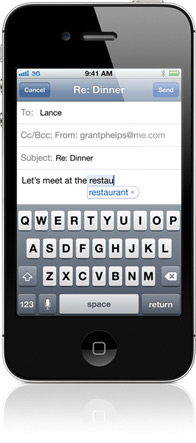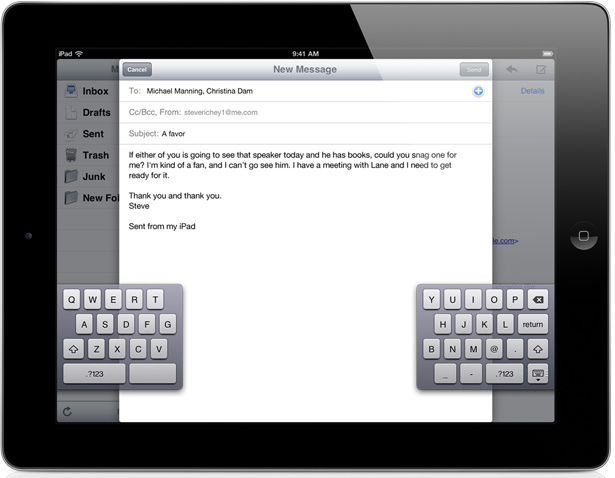Apple working to improve iPhone autocorrect by detecting typing speed, word intent
The details come from three patent applications published by the U.S. Patent and Trademark Office and discovered by AppleInsider on Thursday. Two of the filings deal specifically with automatic typing and spelling correction, while a third application could indirectly relate to the feature.
Timing and Geometry
Application No. 12/976834, titled "Combining timing and geometry information for typing correction," describes a process for using keystroke geometry and timing to better detect a user's intended input.
In one embodiment of the invention, a string of typed characters is timestamped and can be analyzed by a process for use in either autocorrection or autocompletion. The invention also suggests that "baseline typing speed data" could be gathered in order to determine whether double strikes, transpositions or other errors have occurred.
"For example, if the string “theere†is entered and the time between the keystrokes “ee†is less than an associated baseline by more than a threshold amount, the replacement candidate “there†may be assigned a higher score," the application read.
Apple's invention could start with a pre-determined typing speed that would be monitored and adjusted in case users type slower or faster than a "typical" user.
The system would also take into account the location of letters on the keyboard and the geometry of the typed words in order to catch mistakes.
"For example, a word that is similar to the typed text except for one or more errors associated potentially with keyboard geometry, such as differing by a letter where the correct letter is located adjacent to the typed incorrect letter on the keyboard, may be suggested," Apple wrote.
Douglas Davidson and Karan Misra are named as the inventors of the patent, which Apple filed for in late 2010.
Parts of Speech
A second autocorrect-related patent application (No. 12/976849) is entitled "Using parts-of-speech tagging and named entity recognition for spelling correction." The proposed process involves understanding the context surrounding typed words in order to tag their parts of speech and identify named entities, such as differentiating between the company "Apple" and reference to the fruit.
The technical details for Apple's invention are relatively advanced, as they involve a "statistical language model." That process would involve parsing words, phrases and sentences and would make use of clues like capitalization, suffixes and prefixes and other "contextual features."
Apple filed for the patent in December 2010. Brent Ramerth, Douglas Davidson and Jennifer Moore are listed as its inventors.
Contextual Lookup
Apple's application for "Using statistical language models for contextual lookup" (No. 12/976864), closely resembles the aforementioned parts-of-speech tagging application, but it describes a system for applying language processing to search queries.
According to the invention, a process for analyzing parts of speech could help make searching documents or the Internet more efficient. In its filing, Apple provided examples of phrases and words that could be interpreted different ways and would benefit from a process for forming specific and targeted searches.
Autocorrect Lawsuit
Apple has put some of its autocorrect-related patents to work in its legal complaint against rival handset maker Samsung. In February, the compiled asserted a patent for a "Method, system, and graphical user interface for providing word recommendations" against the South Korean company.
Autocorrect on the iPhone has also entered popular culture by giving rise to several Websites documenting humorous or embarrassing instances of the feature, such as Damn You Auto Correct! and Autocorrect Fail.
 Josh Ong
Josh Ong












 Andrew Orr
Andrew Orr
 Sponsored Content
Sponsored Content
 Malcolm Owen
Malcolm Owen

 William Gallagher
William Gallagher

 Mike Wuerthele
Mike Wuerthele
 Christine McKee
Christine McKee







